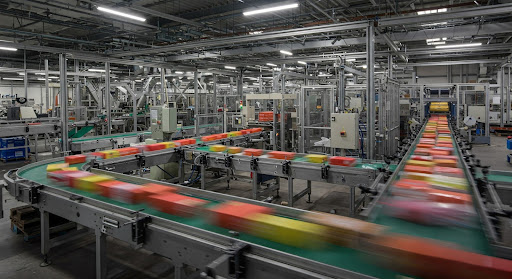
How Engineers Rebuilt Logistics at the speed of life.
Every day, millions of packages crisscross the globe: your new phone, a retailer’s inventory, a hospital’s urgent supplies. In 2024, the U.S. logistics industry handled over 20 billion parcels, a number growing yearly, per Statista. Speed is everything; a delayed shipment can mean a missed sale, a frustrated customer, or a stalled assembly line. Yet, the systems powering these frenzied warehouses, carriers, and tracking apps are often outdated. When a customer checks their order status, they don’t want “processing,” they want answers.
Warehouses juggle thousands of events per second, scans, sorts, and exceptions. Old systems, tethered to data centers, falter under peak loads, like holiday rushes. A 2023 Gartner report noted that 65% of logistics firms rely on monolithic architectures, causing delays in tracking and billing. These bottlenecks don’t just slow packages; they inflate costs and erode trust. Carriers miss manifests, analytics lag, and workers waste hours on manual fixes. For businesses, from e-commerce giants to small shops, the stakes are existential: lose a customer’s package, and you lose their loyalty. The industry needs more than upgrades; it needs a leap to live precision.
Picture a small retailer banking on a restock to meet Black Friday demand, or a parent waiting for a child’s medication. Logistics isn’t abstract, it’s deadlines met, promises kept. Firms must process data instantly, scale effortlessly, and stay resilient through disruptions, all while cutting costs. The solution lies in reimagining how systems talk to each other, turning chaos into clarity. One engineer saw this not as a hurdle, but as a chance to redefine what logistics could be.
Ashwin Chavan, a software architect at a renowned firm, has spent nearly a decade mastering the art of moving goods smarter. From his base in Austin, Texas, he’s led global teams across the U.S., India, and Poland, blending technical grit with a vision for impact. His defining work? The Network Entity Service (NES), a platform modernization initiative that swapped traditional systems for a nimble, event-driven architecture. “It’s not just about speed,” Ashwin says. “It’s about making sure a package gets where it’s needed, when it’s needed.” For the retailer racing to restock or the parent tracking a delivery, his system is the unseen force keeping things on track.
At PB’s GEC unit, a 105-year-old logistics titan, legacy systems groaned under modern demands. Built for batch processing, they updated tracking and billing regularly, leaving customers and warehouses in the dark. “You’d have sorters waiting for data that was already old,” Ashwin states. This wasn’t just slow, it cost hundreds of thousands in overtime and missed carrier deadlines. During peaks, like holiday surges, crashes were common, risking delays across entire supply chains. The monolith, riddled with dependencies, resisted scaling; integrating it with system analytics was a nightmare. Ashwin’s mission: rebuild from scratch for a real-time world.
His answer was NES, a cloud-native platform powered by over a dozen microservices. Using Apache Kafka for event-driven streams, he designed a system that processes warehouse events, scans, sorts, and any parcel movement-related data in near real-time. “It’s like a nervous system,” he explains. “Every move triggers an instant response.” Built on AWS, it scales dynamically, handling peak volumes without a hiccup. Ashwin combined traditional systems with high-availability clusters, enabling real-time lookups for sorters, mobile apps, and analytics. He also hardened the platform with disaster recovery, with the help of integration., NES syncs with billing, carrier systems, and data warehouses, ensuring no package slips through.
Ashwin’s team was able to architect a system that provided the documentation that the monolith lacked. Integrating with external systems carriers, consumer tracking meant aligning mismatched protocols. “You can’t guess what a warehouse needs,” he says. He visited sites, from Texas to California, shadowing workers to get it right. Leading a global team across time zones, he balanced code reviews with strategy, mentoring engineers while pitching NES to leadership. “Buy-in was everything,” he notes. Phased rollouts kept operations live, with Ashwin troubleshooting crashes during peak seasons, like a 2020 COVID surge. The global logistics market is projected to grow to $12.68 billion by 2027, driven by e-commerce demand.
NES cut processing from hours to seconds, enabling real-time tracking, billing, and manifesting. Warehouses gained instant visibility, reducing sorter downtime by 40%. Ashwin’s resume cites near real-time availability as a game-changer. Carrier compliance improved, saving hundreds of thousands annually by catching manifest errors early. Analytics teams accessed live data, fueling sharper forecasts. “It’s not just numbers,” Ashwin says. “It’s a small business meeting a deadline.” A 2024 innovation award, third place, capped NES’s success.
Logistics lives on trust; NES showed real-time systems could deliver it at scale. Most firms still limp along with batch setups; Ashwin’s event-driven model set a benchmark. For small retailers, it meant beating holiday rushes; it meant faster supplies. The system’s logic is scalable, resilient, and real-time, anywhere speed matters.
With e-commerce projected to reach $7 trillion globally by 2025, according to eMarketer, logistics cannot afford delays. NES’s cloud-native, event-driven blueprint offers a path forward. Ashwin is already exploring AI for predictive routing, envisioning a system that identifies delays before they occur. “You don’t stop,” he says. His resume highlights a progression from intern to architect, including roles as SME and team builder. He mentors globally, codes daily, and thrives on warehouse visits. “You see the impact on workers, drivers, and customers. That’s why you build.”
The metrics are stark: 40% less downtime, millions saved, zero crashes during peaks. But the real story’s human. It’s the retailer whose stock arrives for Christmas. The parent whose package lands on time.
Ashwin Chavan’s NES system transformed logistics, slashing warehouse downtime by 40% and saving hundreds of thousands, ensuring retailers met holiday rushes and families received critical packages. Tragically, postal reforms and financial strain plagued the industry. While the company pivoted to other ventures, his cloud-native blueprint remains a key asset for real-time systems, offering scalable, resilient solutions to an industry where speed and trust are paramount, even amidst adversity.



